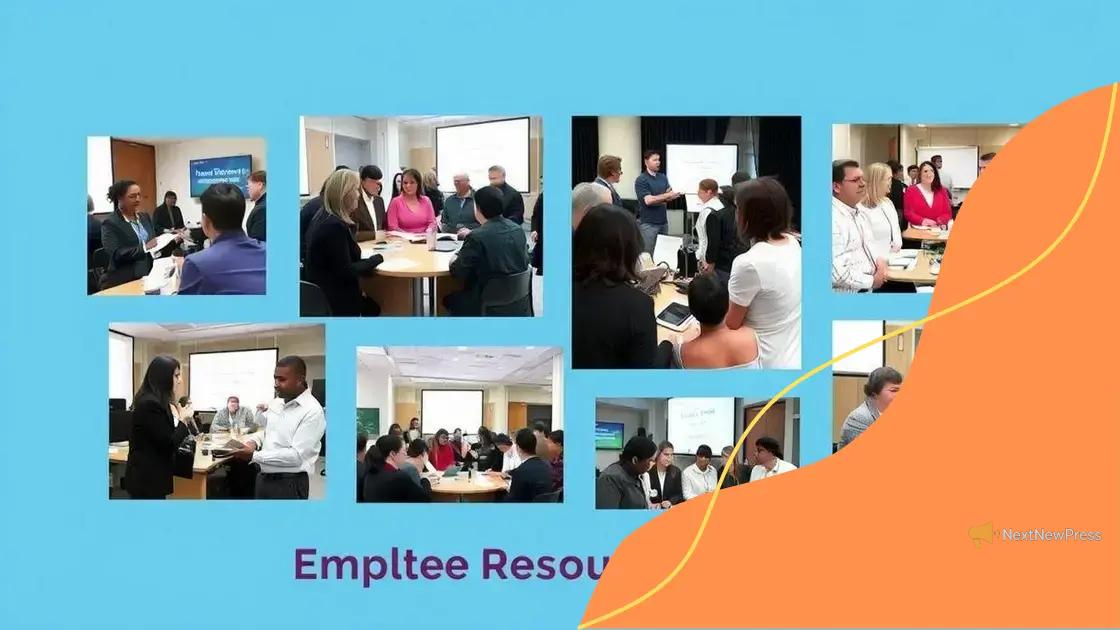Role of ERGs in shaping benefits for employees

The role of ERGs in shaping benefits is crucial as they advocate for inclusive policies, promote diversity, and enhance employee engagement, positively impacting workplace culture and retention.
Role of ERGs in shaping benefits is increasingly recognized within organizations aiming for inclusivity. But how do these Employee Resource Groups actually drive meaningful change in workplace policies and employee satisfaction? Let’s delve into this important aspect.
Understanding ERGs and their purpose
Understanding ERGs (Employee Resource Groups) is essential for fostering an inclusive workplace. These groups play a critical role in connecting employees with shared interests and backgrounds. By bringing together diverse perspectives, ERGs can drive change and create a sense of belonging. Let’s explore the purposes these groups serve.
Creating Community
One of the primary purposes of ERGs is to create a community. Employees who may feel isolated or marginalized often find support within these groups. This sense of community helps employees engage more fully with their work, enhancing overall job satisfaction.
Advocating for Change
ERGs aren’t just about community; they also advocate for change within organizations. By voicing the needs and concerns of their members, ERGs can influence management decisions regarding policies and practices that affect diversity and inclusion.
- Promoting awareness of specific issues.
- Providing recommendations for policy changes.
- Supporting initiatives that enhance diversity.
Furthermore, ERGs often serve as a bridge between employees and leadership. They provide insights that might otherwise go unheard, leading to improved communication and understanding. The formation of these groups can also encourage organizations to adopt more equitable practices, which benefits everyone.
Professional Development
Another purpose of ERGs is to support professional development. These groups frequently organize training sessions, workshops, and mentorship programs. Such activities not only empower members but also equip them with skills that enhance their career trajectories.
Members benefit from networking opportunities, broadening their professional connections. This can lead to new collaborations and career advancements, making ERGs an invaluable resource for personal and professional growth.
Enhancing Employee Retention
Lastly, by fostering a strong sense of belonging, ERGs can improve employee retention rates. When employees feel valued and understood, they are more likely to stay with the organization. This creates a stronger, more cohesive workplace culture.
In summary, ERGs serve multiple purposes that are vital to the success of an organization. They create community, advocate for change, support professional development, and enhance employee retention, making them essential for any inclusive workplace.
The impact of ERGs on employee benefits
The impact of ERGs (Employee Resource Groups) on employee benefits is significant and far-reaching. These groups not only enhance the workplace culture but also shape the benefits offered to employees. When employees are part of an ERG, they often find their voices amplified in discussions about workplace policies and benefits.
Influencing Benefit Policies
ERGs play a crucial role in influencing policies related to benefits. By representing diverse employee interests, they can advocate for changes that meet the needs of specific groups. This advocacy leads to the implementation of tailored benefits that better support employees.
- Health and wellness programs tailored for specific groups.
- Flexible work arrangements based on group feedback.
- Support networks for underrepresented employees.
These tailored benefits often increase overall employee satisfaction and engagement. When organizations prioritize listening to their ERGs, they demonstrate their commitment to inclusion, which attracts and retains top talent.
Promoting Equity and Inclusion
ERGs bring attention to inequities in existing benefits. They can highlight gaps in coverage or services that may not be apparent to leadership. This feedback pushes for more equitable policies that benefit all employees, creating a more inclusive environment.
For example, an ERG may raise concerns about parental leave policies that do not accommodate all family structures. Addressing these concerns leads to adjustments that benefit a broader range of employees.
Enhancing Well-Being
Furthermore, ERGs often work with HR to enhance well-being initiatives. They can suggest programs that address mental health, work-life balance, and professional development opportunities. This ensures that the well-being of all employees is prioritized, resulting in a healthier workplace overall.
In addition, ERGs help foster a culture where employees feel comfortable expressing their needs. This open communication ensures that benefits continuously evolve to meet changing demands.
Ergo, by playing an active role in shaping benefits, ERGs significantly influence employee satisfaction. When companies embrace the insights from these groups, the overall morale and connection within the workplace improve.
Real-world examples of successful ERGs

Real-world examples of successful ERGs highlight how these groups can effectively impact workplace culture and employee satisfaction. Numerous companies have demonstrated the power of ERGs to foster inclusion and drive positive change.
Company A: Driving Change
At Company A, the Women’s ERG has significantly influenced organizational policies. This group organized workshops to discuss career advancement, mentoring, and work-life balance. They successfully advocated for enhanced maternity leave policies, resulting in a more supportive environment for new parents.
Company B: Building Community
Company B has a vibrant LGBTQ+ ERG that focuses on building community and connection. This group hosts regular events, such as Pride celebrations and educational panels, creating a safe space for all employees. Their efforts have not only increased visibility but have also led to improved company-wide diversity training.
- Fostering allyship among employees.
- Increasing participation in diversity initiatives.
- Enhancing employee engagement through social events.
These initiatives empower employees and promote understanding across differences. As a result, the company’s turnover rates have decreased as employees feel more valued.
Company C: Supporting Culture
Company C’s ERG for employees with disabilities has successfully introduced accessibility programs. They conducted an accessibility audit, ensuring that workspaces and events accommodate all employees. This group not only improves workplace policies but also raises awareness about disability issues throughout the organization.
By collaborating with management, they have pushed for more inclusive hiring practices and provided resources for training on disability awareness. These changes help cultivate a more diverse and welcoming workplace culture, benefiting every employee.
Company D: Enhancing Employee Development
Additionally, Company D’s multicultural ERG focuses on professional development. They offer mentorship programs that connect younger employees with seasoned professionals. This initiative has facilitated networking and helped employees from diverse backgrounds develop their skills and advance their careers.
By sharing these real-world examples, it’s clear that successful ERGs not only foster community but also advocate for meaningful workplace changes. They empower employees by providing a platform for their voices and concerns.
How to establish effective ERGs
Establishing effective ERGs (Employee Resource Groups) is essential for promoting diversity and inclusion within the workplace. A well-structured ERG can foster community, enhance employee engagement, and drive meaningful change. Here are some key steps to successfully establish these groups.
1. Define the Purpose
First, it is important to clearly define the purpose of the ERG. Leaders should involve potential members in discussions to identify the specific goals and objectives. This ensures that the group addresses relevant issues and represents the interests of its members.
2. Secure Executive Support
Gaining buy-in from senior leadership is crucial. When executives endorse the ERG, it boosts visibility and credibility. They can also provide resources and funding. Regularly involving executives in ERG activities reinforces their commitment to diversity and inclusion.
- Encourage executives to attend meetings.
- Request funding for specific initiatives.
- Highlight success stories to leadership.
Involving them creates strong advocacy for the group within the organization.
3. Create a Structured Framework
A structured framework is necessary for the effective operation of an ERG. This framework should outline leadership roles, meeting schedules, and communication channels. Defining responsibilities helps maintain organization and ensures that tasks are completed efficiently.
4. Foster Inclusive Participation
To be effective, ERGs must be inclusive. Encourage participation from all employees, regardless of background. Promote the ERG’s activities through various channels so that everyone feels welcome to contribute and join.
Making participation easy and accessible fosters a sense of belonging. For instance, consider virtual meetings and flexible event times to accommodate different schedules.
5. Measure Impact and Adapt
Finally, it’s important to measure the impact of the ERG. Set clear metrics for success and periodically review these. Gathering feedback from members helps to adapt initiatives and keep the group relevant and effective.
This process creates a culture of continuous improvement, allowing the ERG to evolve alongside the organization. Feedback mechanisms, such as surveys and open discussions, strengthen the group’s goals.
By following these key steps, organizations can establish ERGs that are not only effective but also integral to creating a diverse and inclusive workplace.
The future of ERGs in workplaces
The future of ERGs (Employee Resource Groups) in workplaces looks promising as organizations increasingly recognize their value. These groups are essential for promoting diversity, equity, and inclusion, and their impact is expected to grow in the coming years.
Emphasis on Data-Driven Strategies
As companies aim to create more effective ERGs, there will be a stronger emphasis on data-driven strategies. Organizations will use analytics to understand participation rates, member engagement, and the overall impact of ERGs on workplace culture.
Integrating ERGs into Business Goals
In the future, ERGs will likely become more integrated into business goals. Companies will recognize that supporting diversity is crucial for attracting top talent and driving innovation. This alignment will lead to ERGs playing a strategic role in shaping company policies and practices.
- Connecting ERGs with recruitment strategies.
- Aligning diversity goals with overall business objectives.
- Involving ERGs in product and service development.
This will ensure that ERGs are not just an afterthought but a vital part of the organization’s mission and vision.
Increased Support from Leadership
As the importance of ERGs grows, so will the support from leadership. Executives will take an active role in ERG initiatives, attending meetings, and participating in events. This will demonstrate commitment and emphasize the value that diverse perspectives bring to the organization.
As a result, ERGs may receive additional funding and resources, allowing them to implement wide-ranging initiatives. This support will also help raise awareness of the challenges faced by different employee groups.
Focus on Intersectionality
The future will also see a growing focus on intersectionality within ERGs. Recognizing that employees have multiple identities, ERGs will address the unique challenges faced by individuals who belong to more than one underrepresented group.
This approach will foster a more inclusive atmosphere where all employees feel valued and represented. By embracing intersectionality, organizations will create a richer, more diverse culture.
In summary, as organizations continue to evolve, the future of ERGs in workplaces will be defined by strategic alignment, increased support, and a focus on intersectionality. By recognizing and harnessing the power of ERGs, businesses can foster a more engaged and inclusive workforce.
FAQ – Frequently Asked Questions about ERGs in the Workplace
What are Employee Resource Groups (ERGs)?
ERGs are employee-led groups that unite individuals based on shared characteristics, experiences, or interests, promoting inclusivity within the workplace.
How do ERGs benefit companies?
ERGs enhance workplace culture, improve employee engagement, and can influence policies related to diversity and inclusion, leading to better retention rates.
What steps can organizations take to establish effective ERGs?
Organizations can define ERG purposes, secure executive support, create structured frameworks, foster inclusive participation, and measure impact to establish effective ERGs.
How is the role of ERGs expected to evolve in the future?
The role of ERGs will likely expand with a focus on data-driven strategies, increased executive support, and an emphasis on intersectionality to address the diverse needs of employees.





